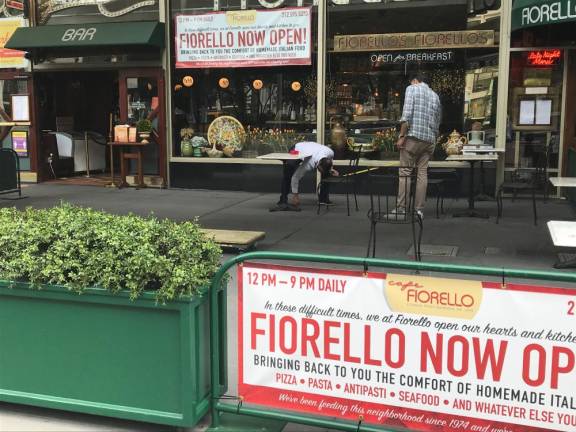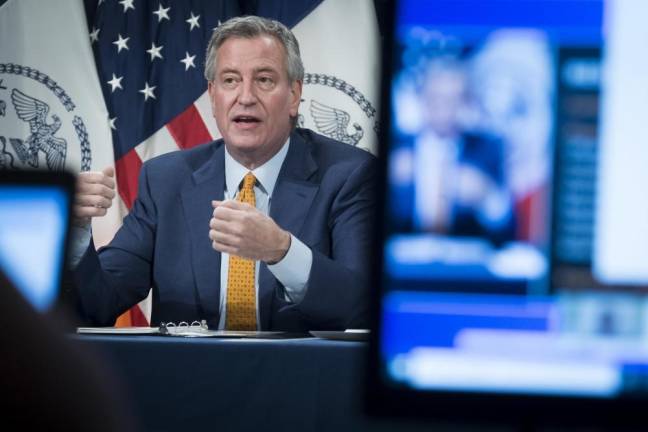Staying Safe in Phase Two
How to keep the virus at bay as New Yorkers start to return to offices, restaurants and shops


New York City embarks this week on Phase Two of its great experiment to see how much of our previous life we can resume without the protection of a vaccine against the coronavirus.
Instead of the “moon shot” science of a safe vaccine, whose arrival, effectiveness and acceptance are all still a matter of speculation, the safe reopening of New York rests for now on following simple science, some of which has been in practice for a century or more.
To succeed at this, New Yorkers need to shed distracting myths about themselves and their city. Last week, the New York Times wrote: “The very factors that made the city an epicenter of the pandemic — its density, tourism and dependence on mass transit — complicated efforts to return to a state of normalcy.”
Not really.
Density and mass transit have been largely debunked as sources of the pandemic (indeed, infection rates are higher in rural areas and other mass transit dependent cities have not had New York’s viral spread). It is true that someone brought the virus here from Europe. But we have no idea if it was a tourist, a returning New Yorker or a business traveler. In any case, we should be so lucky as to have tourism as a challenge. Right now there isn’t any.
Shedding these myths will help New Yorkers to see that a “return to a state of normalcy” is largely in their own hands, which they should wash frequently.
No Magic Bullet
Vast amounts are being spent around the world to create a vaccine: A magic bullet, so to speak, to make us safer.
But for now, our safety is based on the exact opposite idea. That there is no magic bullet, but rather, a series of measures that layered one upon the other substantially reduce the risks.
Those measures fall into three categories:
*Box in the coronavirus.
*Protect yourself and the community
*Improve treatment for COVID-19
These categories rest on proven science developed by generations of epidemic fighters.
There is still no vaccine for HIV, the virus that causes AIDS, for example. Yet in the developed world, containment, protection and reducing the risk of the disease have transformed AIDS from fatal to chronic. There are also important examples of viruses that were stopped by combining a vaccine with one or more of these older strategies. The eradication of smallpox is probably the best known example.
Box in the Virus
The modern science of epidemic control dates back to the mid-19th century. It turns doctors to detectives to identify how a pathogen spreads and stop it. A pump handle is the symbol of epidemiology, from when a vicious outbreak of cholera in London in the Victorian age was traced to a tainted water pump. The pump handle was removed and the epidemic stopped.
There is no pump handle for coronavirus. The source of the virus is infected people spreading it to others. The most effective way to stop the spread is to isolate infected people and trace everyone who has come in contact with them and isolate them, too.
In theory, this alone can halt the infection. That is in theory. We are a long way from contact tracing this effective. Other countries are much more efficient in testing for coronavirus and tracing the contacts of those who test positive, said Dr. Theo Vos, Professor of Health Metrics Sciences at the Institute for Health Metrics and Evaluation at the University of Washington.
“We are a far cry away from having that properly implemented. The typical U.S. system is so dispersed — some state government, some counties. Many just flying by the seat of their pants.”
Some 3,500 people have been put to work tracing infections in the five boroughs. Yet the first report from Mayor Bill de Blasio last week shows the city has a long way to go. From June 1, when the program started, 5,347 new cases of infection were identified. But only about a third of these people shared who they had been in contact with, according to the Mayor’s data.
“We have no idea how/where people are getting infected in vast majority of cases,” Mark Levine, chair of the City Council Health Committee, said on Sunday.
City officials have appealed for public cooperation. The more cooperation, the more the virus will be boxed in. Other countries and communities are doing better. At the same time, even this imperfect system is only the first layer of protection. Infectious cases that get past the test, trace and isolate team can still be kept at a safe distance.
New York Smart
We know much more today than we did four months ago about how coronavirus spreads. Principally, through the air from an infected person to others. This is important. When public health officials realized this they started urging everyone to wear a mask. Dr. Vos says his team has reviewed the data and research and concludes that widespread mask wearing reduces spread of the virus 36%.
A group of researchers in Texas and California have concluded that New York’s decision to mandate masks on April 17 reduced infections “by over 66,000,” about a third of the 209,000 confirmed cases in the city.
“It is rather unfortunate it has become such a politicized issue as it is one of the more effective policy levers we have,” said Dr. Vos. “I’m hoping that even in this environment in the US that with mandates and increasing social pressure, the attitudes will change.”
He cites Hong Kong as a good example of high proportion mask use, at 95%. New York City Transit reports 92% mask use in the subways.
Aerial transmission is also why outdoors is safer than indoors (fresh air dilutes the virus) and why better ventilation indoors reduces risk. Wiping surfaces, washing your hands frequently and maintaining a distance all also remain valuable protections.
Better Health
Even with all these layers of tracing, isolating, mask-wearing, cleaning and distancing, some people will still become infected so long as the virus is “in the community,” as public health officers phrase it. Coronavirus is a treacherous infection, having almost no effect on some and severely sickening others. More is being learned all the time about treatment. There are now two drugs, an antiviral and a steroid, approved for treating seriously ill COVID patients. These are reducing fatalities and hospital stays.
There is another step that would make a major difference. Researchers have identified a set of chronic medical conditions — high blood pressure, diabetes, asthma, obesity and deficiencies of Vitamin D and K – that increase the danger of COVID-19. All of these can be addressed by improving basic community medical services. If we are going to put our hopes on a “moon shot” effort, this is the place. Not only would a concerted push for better basic public health reduce longstanding inequities in medical care, it would reduce the fatality rate among fellow citizens who become infected despite all our other efforts to stop the virus.
“We have no idea how/where people are getting infected in vast majority of cases.” Mark Levine, chair of the City Council Health Committee.